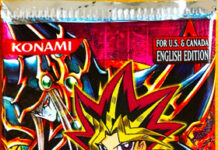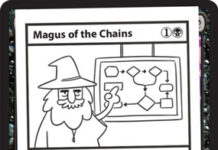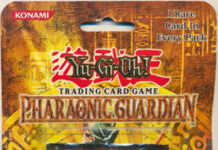My friends and family used to get together on a weekly basis to play board games. Social distancing has put a huge damper on our game nights. Luckily, we have figured out a way to play a handful of games remotely. We now play using Zoom, Skype, Google Meet, Facebook Portal, Amazon Echo Show, etc.
Here is our list of 5 board games that are fun, and play well remotely.
#1 Hive Mind
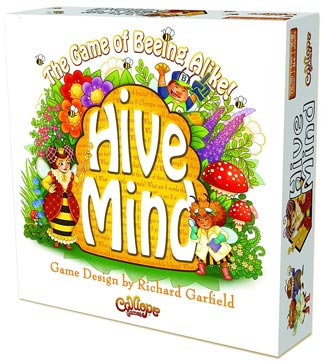
Hive Mind is a party game from designer Richard Garfield. Richard Garfield is the mastermind who created Magic: the Gathering, King Tokyo, RoboRally, Bunny Kingdom, and several other popular games. This is an extremely easy game to play over video chat.
The goal of this game is to try to think like everyone else – thus having a “hive mind”. You do this by answering questions and trying to match the answers of your fellow bees. The more answers you have in common with other players, the more points you get! Bees with the lowest point totals each round will move closer to the hive door. When one or more bees leave the hive, the game is over. The bees still remaining in the hive win! 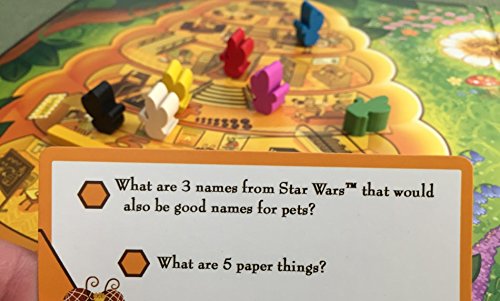
This game is very easy to play remotely, and only one person needs a copy of the game. The remote players just need a pen and paper! Every player is represented by a different colored bee token. And there are 12 tokens in the game to represent 12 different players. You can actually play this game with more than 12 players, by adding more meeples or coins you have laying around. The board is a simple and large diagram of a bee hive.
Question Cards have 3 questions for the active player to pick from. The active player will choose one question and ask everyone that one question. After the question is read aloud, a sand-timer is flipped, and everyone has about 2 minutes to write down their responses.
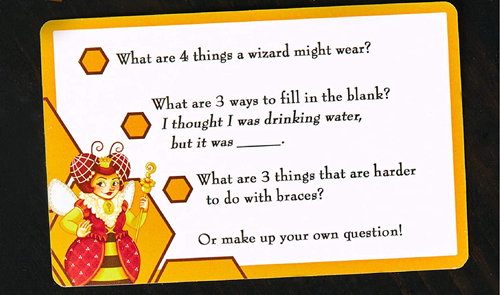
Questions are relatively simple like:
- What are 5 things in the night sky?
- What are 4 scary films?
- What are 5 finger foods?
After the timer is up, the active player reads his answers out loud and checks to see if the answers match anyone else’s answers. For every match (including your own answer), everyone gets 1 point. So even if you don’t match anyone else, you still get at least one point. After the active player finishes, everyone else has a chance to read their different answers, and try to accumulate points by matching others.
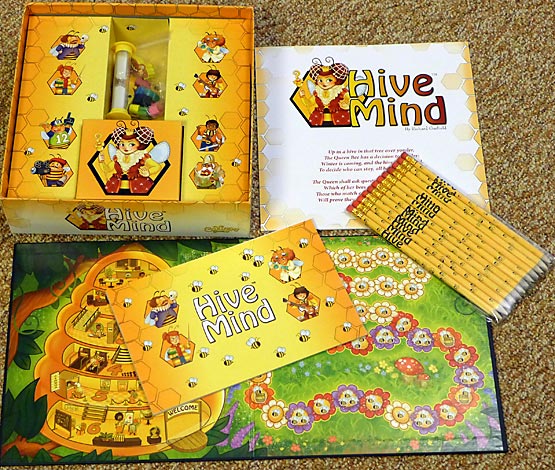
The basic gist of Hive Mind is that if you have the lowest score in a round, your bee will move one step closer to the exit. The game ends when one player exits the hive. That player loses, and everyone else wins.
This game works well remotely. We highly recommend this game. It is extremely easy teach, and often provides many chuckles during game play. When it is a remote player’s turn to pick the questions, we simply hold the card up to the camera, and let that remote player choose the question for the round.
This is a fun game for all ages. We break this game out regularly during holidays with family. We played once with 18 players, the grandparents even played and really enjoyed themselves!
#2 Karuba
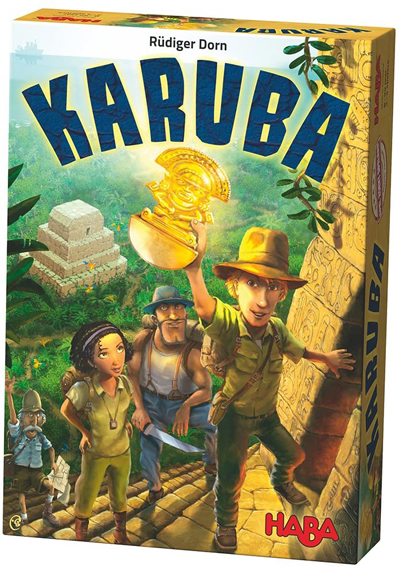
Karuba is a fantastic game for remote play. Karuba was designed by Rüdiger Dorn, who has created many great games, like: Istanbul, Dragonheart, Luxor and Las Vegas.
The only catch here is that every remote player needs access to a physical copy of Karuba to play.
Karuba is a bingo style puzzle game. Every player has their own board, player tokens, and bingo tiles. Each player will leads an expedition team of four adventurers. Players have to navigate their adventurers through the jungle to make it to the temples. Player’s boards are set up initially the same way, and players will be racing each other (independently) to the treasure.
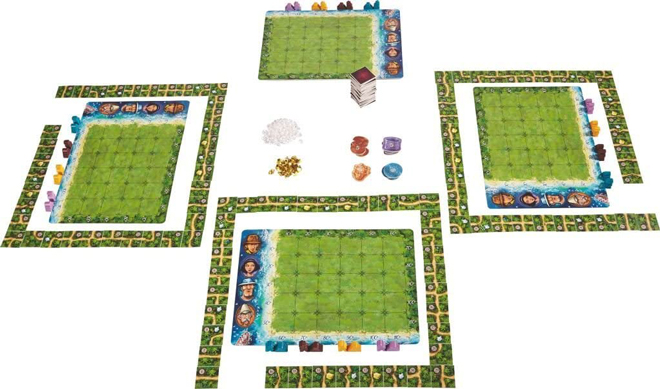
One person will run the game, and call the tiles out in a bingo fashion. Like “Tile #25”. Every player will now place Tile #25 somewhere on their board somewhere. These tiles can be placed anywhere. The tiles are path tiles. Tiles might be straight paths, curved paths, or intersecting paths. Completed paths will allow players to move their adventures down the paths towards the treasure.
Since everyone thinks differently, everyone’s boards will eventually start looking different as well. You never know what tiles will be “bingo-called” next. You will form a plan in your head on how to get to treasures the quickest, but you will have to keep adapting and changing your plans on the fly as different tiles get called. You need to lead your 4 adventurers to their temples.
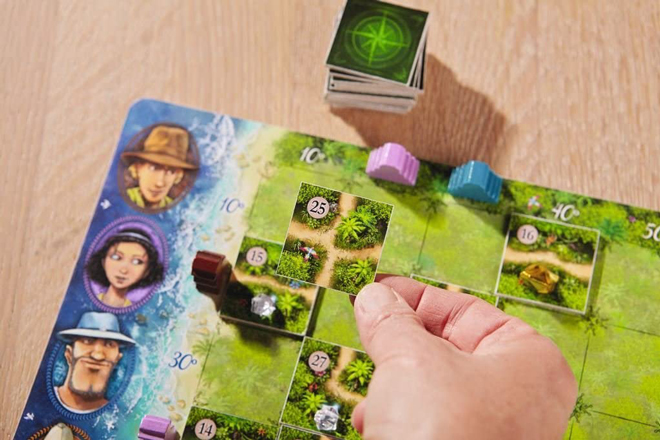
Karuba is a very fun game. It was nominated for Germany’s prestigious 2016 Spiel des Jahres award (for Game of the Year). It is a perfect game to play remotely. The only limiting factor here is that everyone needs their own physical copy of the game. Then again, it is a good game for everyone to own anyway. This is an easy game to play over Skype, Facebook Portal, Echo Show, Hangouts, etc. Games take about 30 minutes to play.
#3 Welcome To …
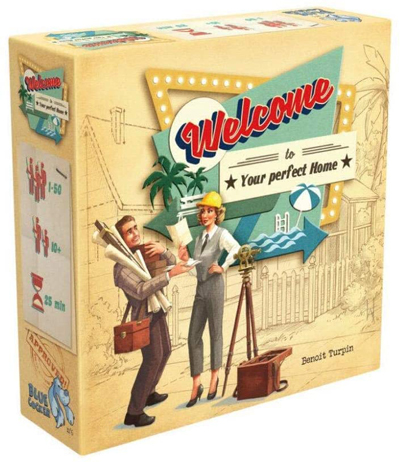
Welcome To … is basically a “Roll and Write game” from Deep Water Games. Think of Roll and Write games as new and improved versions of Yahtzee. Actually Welcome To is a “Flip and Write game”, but most gamers consider both styles to be in the same gaming category. This is a great game because you can play “Welcome To” remotely with an unlimited number of players. And only one person needs a copy of the base game. Everyone else can download Player Sheets to write on. Games only take about 25 minutes to play.
BGG has a webpage with both Color Sheets and Printer Friendly Black & White Sheets for remote players to download and print.
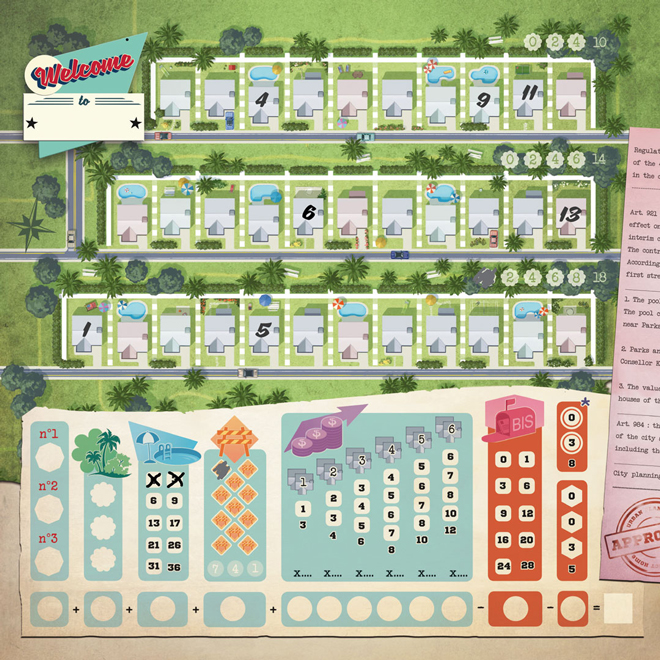
Players compete to be named Best Suburb by giving the houses in their developments the best parks, pools, and curb appeal. The game is perfect for any size playgroup, because everyone takes their turn at the same time.
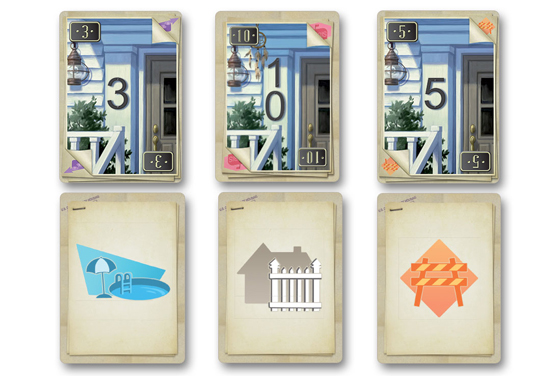
Every round players select which house they want to build out of 3 available choices, writing their selected house onto their player sheet. Each player must write the number from the chosen combination in a house on one of the three streets on their sheet. Numbers must always be written in an empty house and must be written in ascending order from left to right. Players then have the option of taking a bonus action, based on the house they picked.
Whenever everyone says they’re done with an action, the player running the game will flip and reveal 3 new cards. Rinse and repeat until the game is over.
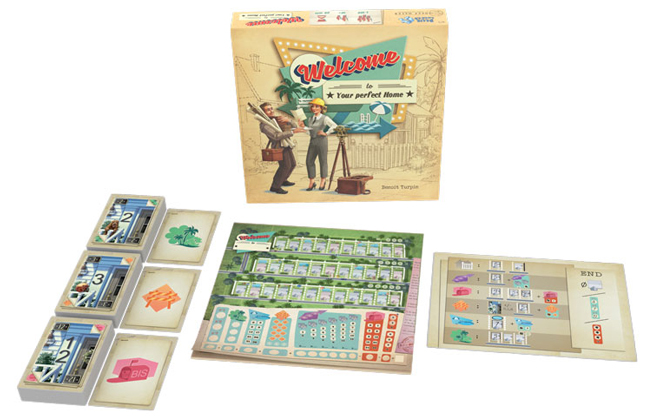
You will need a camera on the game cards in order to play this game. This can be done with Skype, or your phone camera, or conveniently placed Facebook Portal and Echo Show devices. You could even do this via YouTube Livestream.
This is a deceptively simple game, that offers some deeper strategies for adult gamers. Pojo Tip: If someone has a laminator, then laminate the score sheets. And then mail them to all the usual players along with a dry erase marker. 😉
#4 On Tour
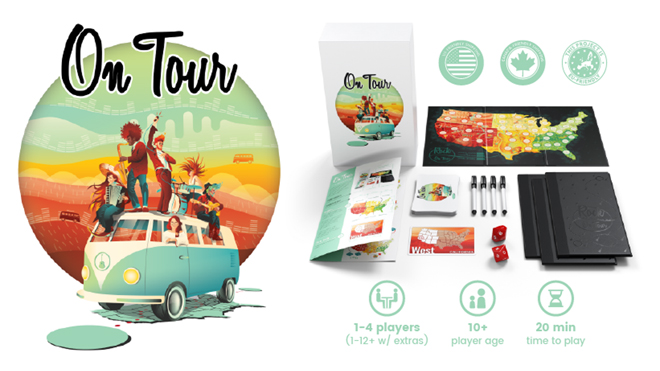
“On Tour” is a fun Roll & Write game from BoardGameTables.com. Many Roll & Write Games are pretty easy to play remotely, and this is one of our favorites. Only one person needs a copy of the base game. Everyone else can download Player Sheets to write on. Click here to download the printable map.
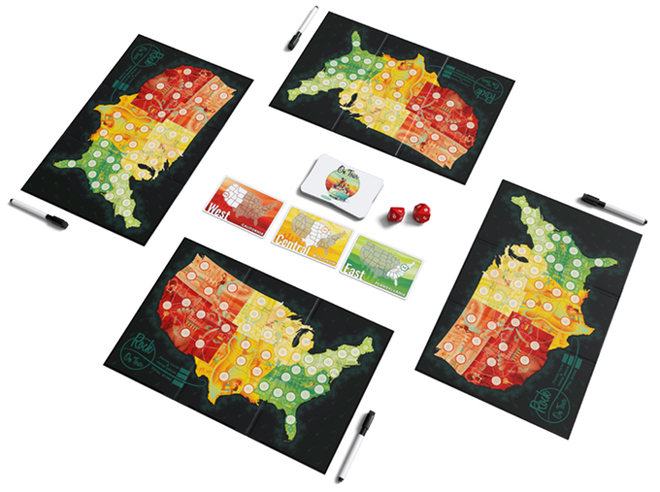
On Tour is a 20 minute route-building, roll-and-write board game. Players share dice rolls and cards to try to visit as many states as possible as they schedule a 100-day tour across the United States for their band.

Every turn, the person running the game will roll two dice, and flip out 3 cards. Every player will then have to write 2 numbers on the board. In the instance of the roll above, you would have to write 37 & 73 on your player sheets.

But players have to write those numbers in one of the regions shown on the 3 face-up cards. And you can only use each card once. For example, you could write 37 in any state in the West region, and then 73 in any state pictured in the East region. A bonus can be awarded if you write the number in the exact state pictured on the card. So if you put 37 in California, and then visit that state on your tour, you will get an extra point.
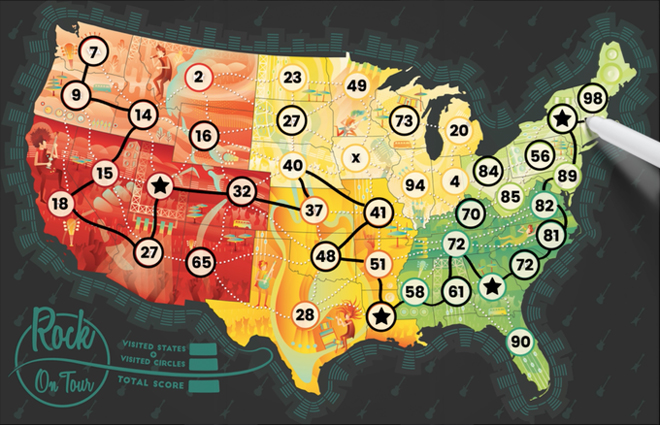
Once you have a number in every state, you will draw a route through as many states as possible to see who wins. Your route must start in a state with a low number and then go to higher and higher numbers.
This is a fun, simple and challenging game. Again, you will need a camera to show game cards and dice in order to play this game. This can be done with Skype, or your phone camera, or conveniently placed Facebook Portal and Echo Show devices. You could even do this via YouTube Livestream.
The downloadable sheets are nice, but the dry erase boards and markers are nicer. Remote players might want to buy their own dry erase boards directly from BoardGameTables.com.
#5 Tiny Towns
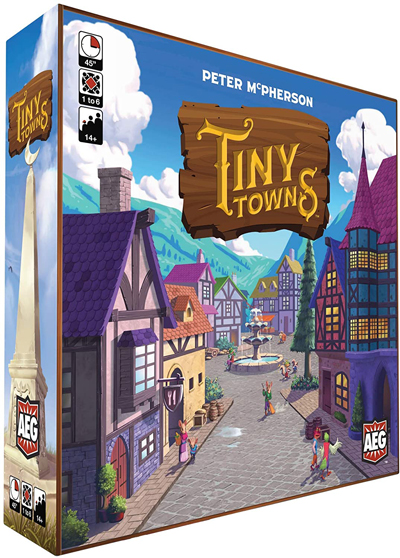
The 5th game on our list is Tiny Towns. Tiny towns gives you that feeling of playing Catan, or Agricola, as you use resources like wood, wheat, brick, glass and stone to build your tiny town.
Like Karuba, everyone playing would need a copy of tiny Towns. The box has enough components for 6 players at one table. We have played Tiny Towns remotely with other families, and each family needs just one copy of the game. Tiny Towns offers a bit more strategy than other games on our list. This is a very easy game to learn and play, but our decisions can be tough.
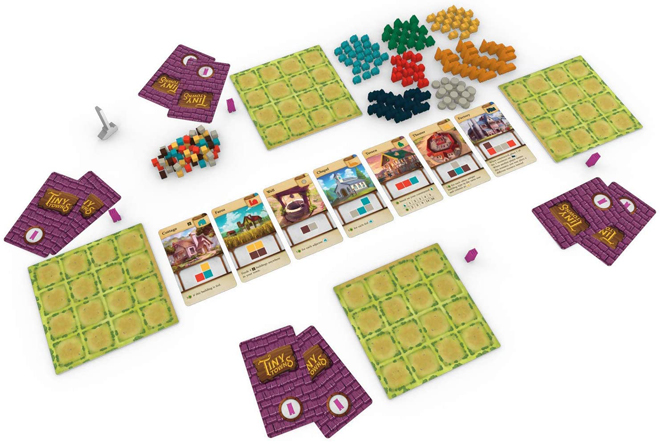
“You are the mayor of a tiny town in the forest in which the smaller creatures of the woods have created a civilization hidden away from predators. This new land is small and the resources are scarce, so you take what you can get and never say no to building materials. Cleverly plan and construct a thriving town, and don’t let it fill up with wasted resources!”
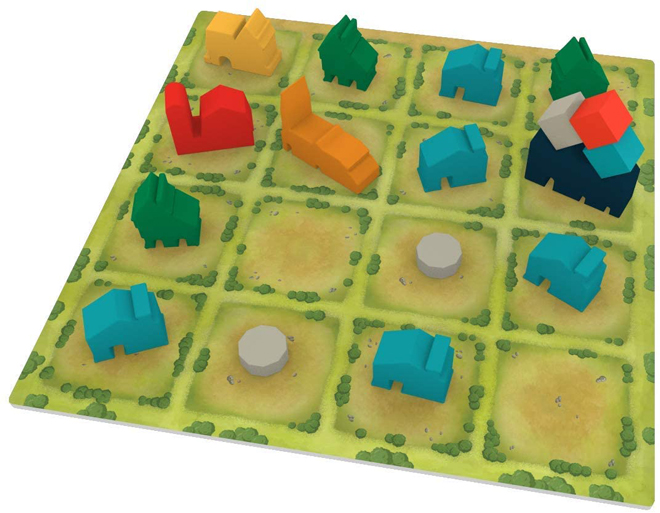
In Tiny Towns, your town is represented by a 4×4 grid on which you will place resource cubes in specific layouts to construct buildings. Each building scores victory points in a unique way. Like many other strategy games, you will be using cubes that represent wood, wheat, brick, glass and stone to build your tiny town.
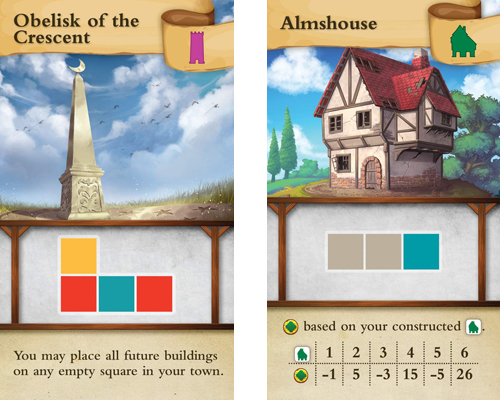
There are 25 different building cards in the box, and 7 will be randomly drawn and placed face up on the table. Players will try to draft and place cubes in their 4×4 grid into the shapes and colors of 7 building cards in play. If you make make that tetris shaped resource pattern on your grid, then you can build that building.
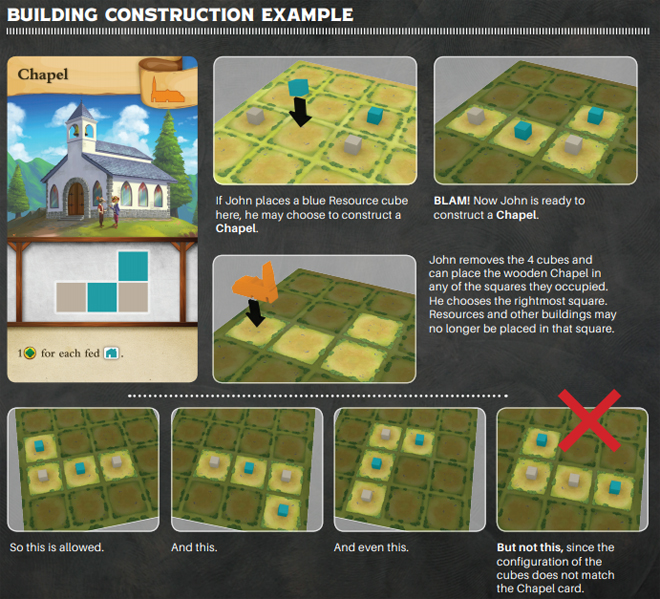
The Master Builder (First Player) will name a resource and everyone will take that resource and place in on their board. All players will do this simultaneously. When they have enough resources, they can also construct buildings on their turns. Once all players have place their resources and constructed buildings, a new round will begin, and another player will become the Master Builder.
This game is simple to teach, and plays well remotely, as long as everyone has access to a copy of the game.

